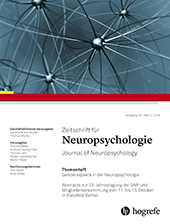Abstract
Zusammenfassung. Während Frauen in der Allgemeinbevölkerung ein höheres Depressionsrisiko aufweisen als Männer, ist die Forschungslage zu Geschlechterunterschieden nach Schlaganfall heterogen. Die vorliegende Längsschnittstudie untersucht Geschlechterunterschiede in der Häufigkeit von depressiven Störungen und Symptomen nach Schlaganfall. An zwei deutschen Rehabilitationszentren wurden N = 174 Schlaganfallpatienten und -patientinnen1 (n = 72 weiblich) rekrutiert und etablierte Risikofaktoren erfasst. Nacherhebungen fanden nach acht und 15 Monaten statt. Depressive Störungen und Symptome waren häufiger bei Frauen (48.2 %) als bei Männern (28.3 %) während der stationären Rehabilitation, jedoch nicht in den Folgeuntersuchungen. Etablierte Risikofaktoren beeinflussten geschlechtsunabhängig die Ausprägung depressiver Symptomatik. In Übereinstimmung mit aktuellen Meta-Analysen zeigten sich keine dauerhaften Geschlechterunterschiede bei Depression nach Schlaganfall. In der klinischen Praxis sollte die Affektlage von Schlaganfallpatienten geschlechtsunabhängig betrachtet werden.
Abstract. Depression in the general population is more frequent in women than in men. In depression after stroke however, evidence regarding gender differences is heterogeneous. This study investigates gender differences in frequencies of depressive disorders and symptoms after stroke. Patients (N = 174, n = 72 female) were recruited from two German rehabilitation clinics, assessed for established risk factors seven weeks post-ictus, and followed up eight and 15 months later. Depressive disorders and symptoms were more frequent in women (48.2 %) than in men (28.3 %) during rehabilitation, but not in follow-up assessments. Established risk factors influenced depressive symptoms irrespectively of gender. In accordance with current meta-analyses, no stable gender differences were found in depression after stroke. In clinical practice, emotional state should be monitored independently from gender.
Literatur
(2017). Depression in later life: A closer look at the gender gap. Social Science Research.
(1996). Diagnostisches und statistisches Manual psychischer Störungen-DSM-IV. Deutsche Bearbeitung u. Einleitung von H. Sass, H.-U. Wittchen, M. Zaudig. Göttingen: Hogrefe.
(2013). Diagnostic and statistical manual of mental disorders (DSM-5®): American Psychiatric Pub.
(2002). Gender differences in depression. European Archives of Psychiatry and Clinical Neuroscience, 252(5), 201–209.
(2013). Natural history, predictors and outcomes of depression after stroke: Systematic review and meta-analysis. The British Journal of Psychiatry, 202(1), 14–21.
(2013). Depression after stroke and risk of mortality: A systematic review and meta-analysis. Stroke Research and Treatment, 2013.
(2011). How mothers and fathers share childcare: A cross-national time-use comparison. American Sociological Review, 76(6), 834–861.
(2009). What are the social consequences of stroke for working-aged adults? Stroke, 40(6), e431–e440.
(2010). Statistik und Forschungsmethoden. Weinheim Beltz.
(1975). “Mini-mental state”: A practical method for grading the cognitive state of patients for the clinician. Journal of Psychiatric Research, 12(3), 189–198.
(2007). F-SOZU: Fragebogen zur sozialen Unterstützung. Göttingen: Hogrefe.
(2017). Sex differences in stroke: Review of current knowledge and evidence. Vascular Medicine, 22(2), 135–145.
(2014). Part I: Frequency of depression after stroke: A updated systematic review and meta-analysis of observational studies. International Journal of Stroke, 9(8), 1017–1025. doi:10.1111/ijs.12357
(2009). Gender-related explanatory models of depression: A critical evaluation of medical articles. Public Health, 123(10), 689–693.
(2012). Why is the sex gap in feelings of depression wider in high gender equity countries? The effect of children on the psychological well-being of men and women. Social Science Research, 41(3), 501–513.
(1983). Aachener Aphasie-Test:(AAT). Göttingen: Hogrefe.
(2001). Gender differences in the rates of exposure to stressful life events and sensitivity to their depressogenic effects. American Journal of Psychiatry, 158(4), 587–593.
(2014). Part II: predictors of depression after stroke and impact of depression on stroke outcome: an updated systematic review of observational studies. International Journal of Stroke, 9(8), 1026–1036.
(2015). Predictivity of early depressive symptoms for post-stroke depression. The Journal of Nutrition, Health & Aging, 19(7), 754–758.
(1965). Functional evaluation: The Barthel Index: A simple index of independence useful in scoring improvement in the rehabilitation of the chronically ill. Maryland State Medical Journal, 14, 61–65.
(2002). Modified National Institutes of Health Stroke Scale for use in stroke clinical trials. Stroke, 33(5), 1261–1266.
(2005). Motor and functional recovery in patients with post-stroke depression. Disability and Rehabilitation, 27(4), 170–175.
(1989). The sociological study of stress. Journal of Health and Social Behavior, 30(3), 241–256.
(2009). Sex differences in the prevalence of post-stroke depression: A systematic review. Psychosomatics, 50(6), 563–569.
(2008). Sex differences in stroke: Epidemiology, clinical presentation, medical care, and outcomes. The Lancet Neurology, 7(10), 915–926.
(2010). Poststroke depression: A review. The Canadian Journal of Psychiatry, 55(6), 341–349.
(2008). Health inequalities among the elderly in western Europe. Journal of Epidemiology & Community Health, 62(6), 492–498.
(2017). Gender differences in depression in representative national samples: Meta-analyses of diagnoses and symptoms. Psychological Bulletin, 143(8), 783–822.
(2017). Risk Factors for Post-stroke Depression: A Meta-analysis. Frontiers in Aging Neuroscience, 9(218). doi:10.3389/fnagi.2017.00218
(2000). Sex differences in late-life depression. Acta Psychiatrica Scandinavica, 101(4), 286–292.
(2017). Poststroke depression: A scientific statement for healthcare professionals from the American Heart Association/American Stroke Association. Stroke, 48(2), e30–e43.
(2010). Gender differences in depression in 23 European countries. Cross-national variation in the gender gap in depression. Social Science & Medicine, 71(2), 305–313.
(2018). General self-efficacy as a driving factor of post-stroke depression: A longitudinal study. Neuropsychological Rehabilitation, 1–13.
(1977). Sex differences and the epidemiology of depression. Archives of General Psychiatry, 34(1), 98–111.
(2016). A two-phase pathogenetic model of depression after stroke. Gerontology, 62(1), 33–39.
(1997). SKID I. Strukturiertes Klinisches Interview für DSM-IV. Achse I: Psychische Störungen. Interviewheft und Beurteilungsheft. Eine deutschsprachige, erweiterte Bearb. d. amerikanischen Originalversion des SKID I. Göttingen: Hogrefe.
(1983). Development and validation of a geriatric depression screening scale: A preliminary report. Journal of Psychiatric Research, 17(1), 37–49.
(2017). The association between lesion location, sex and poststroke depression: Meta-analysis. Brain and Behavior, e00788.



